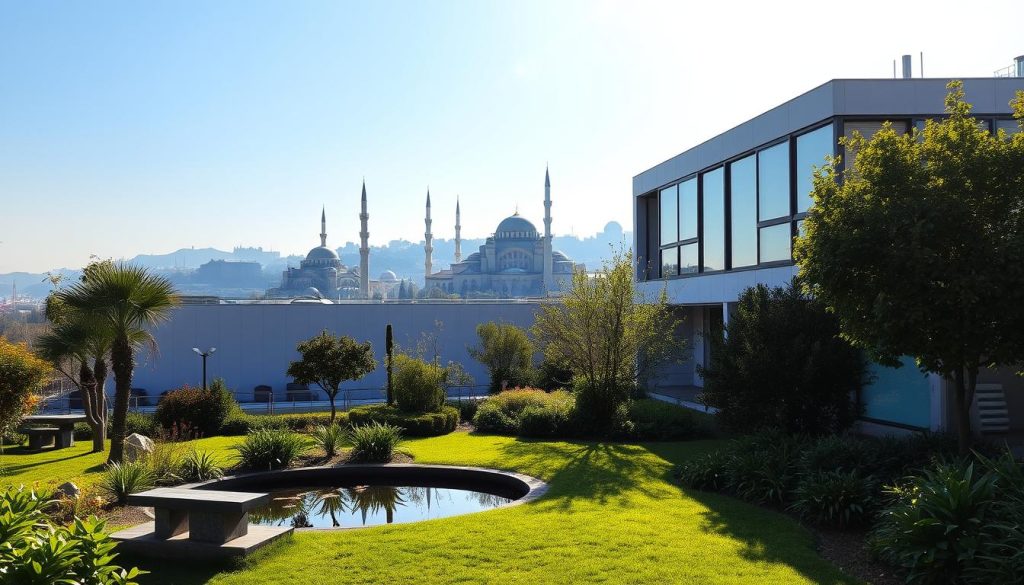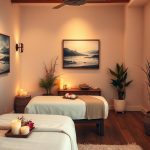Can a city’s traditions and green spaces actually change how you handle pressure at the office? You will find a clear roadmap here to choose the right approach and protect your health while you meet job demands.
You can use local hammams, modern spas, parks, and yoga studios to build short, effective routines that fit your calendar. Regular visits to baths or quick nature walks in Emirgan Park and Belgrad Forest offer fast recovery between meetings.
Simple, repeatable habits—like a 20-minute guided session from Headspace or a lunchtime yoga class at Yogaala—help sustain mental health and employee well-being. Learn which options match your time and energy, and how small bets add up to steady improvement.
For practical guidance on professional support and city resources, see a detailed local overview at mental health and wellness in Istanbul and explore onsite massage options via professional massage services.
Key Takeaways
- Mix old and new: combine hammams, parks, and studios for balanced routines.
- Short sessions fit busy schedules—try 15–30 minute practices.
- Nature and massage offer quick physiological relief between tasks.
- Pick options that match your stress level and workplace context.
- Track small wins to build lasting employee well-being.
Why Work Stress in Türkiye Demands Action Today
Rising pressure at Turkish offices has created a clear business and human risk that needs urgent attention. You should know the numbers so you can act to protect people and performance.
The present-day picture: stress levels, burnout risks, and talent retention
Nearly half of respondents report their job as stressful. About 47% said demands made them consider quitting, and 29% would take lower pay for less pressure.
Top causes are clear: 32% cite lack of recognition, 27% point to overwhelming workload, and 33% struggle to balance life and work. Only 14% say their employer offers mental health support.
| Cause | Share | Immediate action |
|---|---|---|
| Lack of recognition | 32% | Simple rewards and regular feedback |
| Overwhelming workload | 27% | Task triage, protect focus time |
| Poor work–life balance | 33% | Flexible hours or hybrid options |
| Low mental health support | 14% | Offer EAPs and counseling access |
What you need most: recognition, workload relief, and work-life balance
Managers and leadership must act on clear needs. Replacing an employee costs the business 6–9 months of salary, so prevention saves money and morale.
Simple solutions—better recognition, reduced overload, and flexible schedules—make employees feel valued and cut burnout fast. Pilots like a four-day schedule or remote options lowered stress for many while keeping productivity steady.
Traditional Turkish Baths: Turning Hammams into Weekly Stress Resets
The hammam experience blends heat, touch, and ritual to provide a reliable recovery slot during a busy week.
How heat, exfoliation, and massage calm your nervous system
Begin with heat: Time in a heated marble room raises skin temperature and relaxes tight muscles. This signals your nervous system to shift away from high-alert states and lowers perceived tension.
The kese exfoliation and foam wash act like guided mindfulness. The steady rhythm of touch draws attention to the body, helping you release anxiety and reset focus before returning to your routine.
Structure 60–90 minute sessions midweek or on weekends to build a predictable recovery window. Hydrate, choose a lighter meal beforehand, and allow quiet time after a session to extend relaxation.
Pick a place that suits your comfort—historic hammams for atmosphere or modern venues for privacy. Consider a private room or off-peak hours if you want a calmer sensory setting.

Track how your tension and sleep change after regular visits. Pair simple breathing exercises with the ritual to anchor calm and return to demanding days with clearer focus. For onsite massage and pool options, see best massage and pool experiences.
Modern Wellness Centers in Istanbul: Blending Heritage with High-Impact Recovery
Many contemporary health hubs now offer integrated programs that combine therapy, movement, and short-format sessions for busy professionals.
These centers let you find stress management sessions, mindfulness workshops, and therapy under one roof. The Four Seasons Hotel Istanbul at the Bosphorus is an example where spa treatments sit alongside classes focused on breath and focus. You can access coaching, guided meditation, and clinical support without long commutes.
How to pick the right place for your needs
Compare hours and session types so offerings match your schedule. Look for short classes that fit lunch breaks and evening appointments that respect your daily routine.
Check the environment: quiet zones, relaxation lounges, and thoughtful sensory design help your nervous system downshift quickly.
- On-site professionals: therapists, coaches, and teachers let you tailor a plan.
- Formats: choose between one-on-one therapy and group sessions for cost and privacy balance.
- Corporate options: memberships or receipts can make regular access affordable for employees.
| Feature | Why it matters | What to ask |
|---|---|---|
| Session length | Fits around busy schedules | Are there 20–40 minute options? |
| Modality mix | Combines massage, breathwork, and coaching | Can you bundle services with one provider? |
| Environment | Calms the nervous system faster | Is there a relaxation lounge or quiet room? |
| Corporate support | Encourages consistent use by employees | Do you offer memberships or employer billing? |
Brief your provider about current pressures so sessions target real triggers. Set clear success metrics—better focus, steadier mood, fewer late-night wakeups—and review them with management or your coach.
Nature as Therapy: Where to Lower Stress Levels in Istanbul’s Green Spaces
Short doses of green time between meetings can reset your focus faster than a coffee break.
Map nearby spots such as Emirgan Park and Belgrad Forest to create easy micro-breaks. Ten to twenty minute walks among trees, near water, or under bird song restore attention and improve health markers more efficiently than staying at a desk.

Micro-breaks vs. long walks: time-efficient ways to decompress today
Use short sessions during the day and plan longer weekend routes for deeper recovery. Pair mindful walking with light breathwork to amplify benefits when your environment feels overstimulating.
Pick places with tree cover, water features, or rich birdlife to get the most physiological advantage. Block these sessions on your calendar so they become protected commitments that keep your routine steady.
“Nature does not hurry, yet everything is accomplished.”
- Track simple metrics: mood before/after, perceived stress, sleep quality.
- Bring water or a light snack to avoid afternoon crashes and sustain concentration.
- Try buddy walks with colleagues to make breaks social and accountable for employees.
| Time | Action | Benefit |
|---|---|---|
| 10–20 min (lunch) | Micro-walk in nearest park | Quick attention reset, lower stress |
| 30–60 min (evening) | Mindful stroll with breathwork | Better sleep, steadier mood |
| 90+ min (weekend) | Long walk in Belgrad Forest or Emirgan | Deeper recovery, improved energy |
Make nature time part of your commute or calendar and test its benefits. For guided programs that combine green time with coaching, see a local holistic program, or explore options for onsite massage and recovery at best massage salons.
Mindfulness in Practice: Meditation and Yoga You Can Start This Week
Start small: ten minutes of guided breathing can change how you handle midday pressure. Pick a reliable app or a nearby studio and plan brief slots that match your calendar.
From guided meditation to Vinyasa: matching styles to your stress levels
Low energy or high tension: choose guided breathwork or short meditations from Headspace. These protect your health and stop escalation.
Moderate tension: try Hatha for steady movement and gentle stretching. It helps reset posture and breathing before meetings.
High alert or restless: a short Vinyasa flow can use movement to release tightness without tiring you out.
Building consistency: realistic sessions around your hours
Block 10–20 minute sessions before work or between meetings. Use calendar holds and visual cues to make them habitual.
Team options: group classes for shared support
Invite a colleague to a low-pressure class at Yogaala or schedule a weekly group meditation. Group time builds social support and keeps employees accountable.
| Format | Suggested time | Key benefit |
|---|---|---|
| Guided breathwork (app) | 10 min | Immediate calm and focus |
| Hatha (studio) | 20–40 min | Steady movement, improved posture |
| Vinyasa (studio) | 30–45 min | Release tension, boost energy |
Track outcomes—focus, patience in meetings, and sleep—and treat missed days as data. For local guidance on routines and massage options, see this helpful mindfulness and massage guide.
Eat for Calm: Istanbul’s Food Culture and Your Mental Health
Eating with intention in this city helps you protect mental health and sustain steady energy. Fresh fish, legumes, vegetables, and fermented sides support gut and brain links that improve overall health.
Pick a place near your office for balanced plates to cut decision fatigue. Karaköy Lokantası and similar lokantas emphasize locally sourced ingredients, making simple swaps to avoid sugar spikes.
Adopt a Mediterranean-style pattern—olive oil, beans, whole grains, and fish—to boost concentration and limit afternoon slumps. Plan quick breakfasts and carry portable snacks so you don’t skip meals during busy days.
Hydrate and time caffeine to protect sleep; this compounds benefits for resilience. Use Sunday meal prep or smart ordering to keep balance when deadlines compress your schedule.
Align meals with short mindfulness breaks to curb mindless eating. Track how certain foods change your mood and focus, and adjust your plan for lasting health and lower stress at the office.
For ideas on short recovery options that pair with good eating habits, see a helpful relaxing massage techniques.
Wellness Practices That Reduce Work Stress in Istanbul at Work: Practical Strategies for Teams and Leaders
Clear norms and simple rituals give managers tools to protect focus and lift morale fast.
Ramp up recognition
Make recognition daily and specific so employees feel seen. Use peer-to-peer platforms like Merck’s INSPIRE for quick messages, points, or small rewards.
Recognition closes the 32% gap shown in surveys and helps retention and productivity.
Ease the workload
Simplify tasks, cut unnecessary meetings, and protect focus blocks. Set meeting-free windows and encourage short agendas.
Prioritize work-life balance
Offer flexible hours and remote options with clear norms. Sixty-four percent report remote setups are less stressful—model the changes from leadership downward.
Open the conversation
Run anonymous pulse surveys with Google Forms or SurveyMonkey. Pair results with regular 1:1s to build psychological safety and faster support paths.
Pilot a four-day week
Start small: define productivity metrics, equity checks, and environmental measures. Trials show maintained output and better mental health for many employees.
“Small, consistent changes in the work environment often yield the biggest gains in productivity and retention.”
- Define rituals: quiet hours, no-meeting windows, daily check-ins.
- Set escalation paths for resource gaps and role conflicts.
- Document initiatives, assign owners, and review monthly.
| Action | Why it matters | Quick metric |
|---|---|---|
| Daily recognition program | Employees feel valued; reduces turnover | % participation, retention rate |
| Protected focus blocks | Higher productivity and fewer interruptions | Tasks completed per sprint |
| Four-day pilot | Improves balance and equity; reduces commute emissions | Delivery metrics, stress survey |
Professional Help and Resources: When to Seek Clinical Support
If sleep, mood, or performance keep slipping, it’s time to check clinical options and confidential supports.
Spotting regular strain versus burnout
Regular stress is often short-lived and tied to a deadline or busy season. Burnout is prolonged exhaustion with detachment and falling performance.
Watch for warning signs: persistent fatigue, sleep problems, headaches, anxiety, irritability, social withdrawal, and steady drops in output.
Employee assistance and counseling: confidential pathways
Use employee assistance or local counseling to get timely, private help. These resources connect you with professionals who tailor care to real workplace issues like excessive workload or bullying.
Brief your counselor about your role, key triggers, and timelines so treatment matches your needs.
- Distinguish duration and detachment to identify burnout.
- Involve managers only as needed to adjust task loads and protect privacy.
- Set time-bound checkpoints to review symptom relief and return-to-work plans.
- Collect hotlines, local clinicians, and digital tools for easy access on tough days.
“Early, confidential support often prevents anxiety and prolonged burnout.”
Measuring Impact: How You Track Stress Management Success
Measure impact with simple, repeatable metrics so your team sees what success looks like. Start with a short dashboard that tracks satisfaction, absenteeism tied to health, productivity outputs, and stress levels.
Core metrics: satisfaction, absenteeism, and productivity levels
Track satisfaction through short surveys that run monthly. Use exit and pulse checks to spot trends by team and role.
Monitor absenteeism and tag entries related to health or fatigue. That helps locate hotspots and prioritize initiatives.
Measure productivity with outcome metrics—deliveries, cycle time, and completed objectives—not just hours logged.
| Metric | Why it matters | How to measure |
|---|---|---|
| Satisfaction score | Signals morale and perceived support | Monthly pulse survey, segmented by team |
| Absenteeism | Shows health-related impact | Days lost, coded by cause |
| Productivity outputs | Links initiatives to delivery | Completed work, cycle time, quality |
Sustaining momentum: leadership’s role in culture and ongoing initiatives
Leadership must own solutions. Assign managers to each initiative and run monthly reviews to keep accountability clear.
Align actions to metrics—recognition cadence, meeting load, and protected focus time should map to changes you expect to see.
“Publish lightweight updates so employees see progress and trust the process.”
- Segment data by team and role to test local solutions.
- Budget for quick wins and longer-term training or coaching.
- Compare before/after pilot data to confirm scalability.
Conclusion
Finish by mapping a few small, repeatable habits that match your calendar and team needs. Pick two or three actions you can start this week and protect time for them on your calendar.
Combine local assets—baths, parks, short studio sessions—and simple workplace moves like recognition and focus blocks. Track sleep, mood, and delivery so you can prove progress and get leadership buy-in.
Seek help early when burnout signs appear and use evidence-based resources such as an evidence-based review. Explore practical options and reputable providers for recovery, including local massage options.
Small, steady steps build a culture where employees keep their health and role performance strong.






